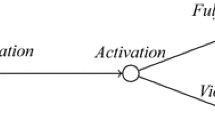Abstract
In a social situation actors need to cooperate in order to achieve their goals. Instead of using a fixed collection of rules to model social knowledge this paper investigates the process of dynamic acquiring and developing social knowledge by actors. Based on the Soar architecture actors develop a world representation that encompasses models of other actors and preferable action patterns for social cooperation. The multiactor virtual experiment shows the feasibility of this approach and demonstrates the emergence of collaboration deadlocks and the role world representation plays in solving these deadlocks.
Access this chapter
Tax calculation will be finalised at checkout
Purchases are for personal use only
Preview
Unable to display preview. Download preview PDF.
Similar content being viewed by others
References
Carley, K., and M. Prietula (1994), ACTS theory: extending the model of bounded rationality. In: Carley, k., and M. Prietula (eds.) Computational organization theory. Lawrence Erlbaum Associates.
Carley, K. M. and A. Newell (1994) The Nature of the Social Actor. Journal of Mathematical Sociology, Vol. 19(4), 221 - 262.
Cohen, M.D. (1992), When can two heads learn better than one? Results from a computer model of organizational learning. In: M. Masuch M. Warglien (eds.) Artificial Intelligence in Organization and Management Theory: Models of Distributed Activity. Amsterdam: North-Holland.
Conte, R. G. Castelfranchi. (1995) Cognitive and social action. London: UCL Press Limited.
Laird, J.E., A. Newell, P.S. Rosenbloom. (1987) Soar: An Architecture for General Intelligence. Artificial Intelligence, 33, 1 - 64.
March, J. S., H. A. Simon (1958/1994) Organizations [Second Edition]. New York: Wiley.
Schmidt, K. (1991) Cooperative Work: A Conceptual Framework. In J. Rasmussen, B. Brehmer, J. Leplat (eds.) Distributed decision making, cognitive models for cooperative work. Wiley Sons.
Russell, Stuart, Peter Norvig. (1995) Artificial Intelligence: A modern approach Prentice-Hall
Author information
Authors and Affiliations
Editor information
Editors and Affiliations
Rights and permissions
Copyright information
© 1997 Springer-Verlag Berlin Heidelberg
About this paper
Cite this paper
van den Broek, H., Gazendam, H.W.M. (1997). Organizational Actors and the Need for a Flexible World Representation. In: Conte, R., Hegselmann, R., Terna, P. (eds) Simulating Social Phenomena. Lecture Notes in Economics and Mathematical Systems, vol 456. Springer, Berlin, Heidelberg. https://doi.org/10.1007/978-3-662-03366-1_25
Download citation
DOI: https://doi.org/10.1007/978-3-662-03366-1_25
Publisher Name: Springer, Berlin, Heidelberg
Print ISBN: 978-3-540-63329-7
Online ISBN: 978-3-662-03366-1
eBook Packages: Springer Book Archive



